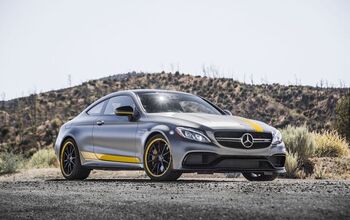Report: Mercedes-AMG Bringing Back V8 Engines

Word has it that Mercedes-AMG is mulling over how best to bring back V8 power to the C and E-Class. While the performance unit downsized its powertrains in a bid to be more emissions compliant, fans pointed out that AMG had long been synonymous with under-stressed and over-engineered V8s making enough power to burn through a set of tires in a single outing.
The shift ended up being a bit of a scandal and one that left a sour taste in the mouth of the people that would actually buy AMG-branded products — which may explain the claimed change of heart.
According to two unnamed sources speaking with Car and Driver, Mercedes-AMG is in the midst of deciding how to bring back the V8. Though the overarching plan remains ambiguous, the rationale behind it is anything but.
From Car and Driver:
The AMG community is not amused. The most powerful AMG C-class, the C63, traded the V-8 for a hybridized turbo-four, and the next top-of-the-line E-class, the upcoming E63, will make do with an inline-six plug-in-hybrid setup. Some say that's not good enough to do battle with the BMW M3, which has a twin-turbo inline-six, and the future BMW M5, which is slated to have a hybrid setup with a twin-turbo V-8. The upcoming Audi RS5 and RS7 will also be powered by a V-6 hybrid good for up to 640 horsepower.
The only escape route out of this dilemma is the reinstitution of the M177 4.0-liter V-8 engine, which will return to the C- and E-class in 2026, two independent sources say. The eight-cylinder is currently being modified to meet EU7 emissions standards. This engine is currently used in the 831-hp AMG GT63 S E Performance and the 791-hp AMG S63, and it's combined with a hybrid setup in both of those applications.
It would be stupid to pretend that a 2.0-liter Mercedes optimized for performance can’t still be a hoot to drive. The iconic Mercedes-Benz 190E (W201) is an absolute legend with the 2.0-liter. But there’s a reason models featuring the I6 tend to be more sought after. It isn’t because they’re more reliable, it’s definitely not because they’re cheaper to run, and it might not even have all that much to do with their being faster. People want the larger engines to have the mental satisfaction of knowing they’re driving something with a larger engine.
It’s the same reason someone with a family of four opts to buy the trail-rated SUV that’s a little too big for the garage and will never actually be taken off-road. A Toyota Camry may have served them better. But it wouldn’t have made the neighbors envious. Despite the less-is-more concept being applicable in certain situations, the appearance of wealth and prestige demands one take the more-is-more approach.
While perky little four-bangers have a lot to offer, their implementation can sometimes be a little disappointing. Imagine you’ve been given a free Ford Mustang with the badging removed and are told to open the hood to see which motor is inside. Your level of excitement is going to be determined almost entirely by how many cylinders you find.
Compact cars can thrive on small and peppy turbocharged motors. But there’s something truly sad about seeing one tucked inside an engine bay of a vehicle that could have accommodated something larger — especially when it’s also a premium luxury product that costs as much as some starter homes.
Based on the report, AMG only needs to make some minor adjustments to the C and E-Class to accommodate the “biturbo” V8, battery pack, and electric motor. There’s also a chance the powertrains will stick around for a while, too. Plug-in hybrids are given more regulatory leeway and the models are presently under evaluation to persist beyond 2028. The worst-case scenario is that we’ll probably see V8 AMGs for a couple of years, starting in 2026. However, the report makes it seem like they’ll be persisting beyond 2030.
That would certainly be welcome news. But it may not be wise to get too comfortable with the idea, as it wasn’t that long ago when Mercedes-Benz said it was just about done with the V8. Never forget that you’re just one development cycle away from nobody having to keep their promises.
[Image: Mercedes]
Become a TTAC insider. Get the latest news, features, TTAC takes, and everything else that gets to the truth about cars first by subscribing to our newsletter.

A staunch consumer advocate tracking industry trends and regulation. Before joining TTAC, Matt spent a decade working for marketing and research firms based in NYC. Clients included several of the world’s largest automakers, global tire brands, and aftermarket part suppliers. Dissatisfied with the corporate world and resentful of having to wear suits everyday, he pivoted to writing about cars. Since then, that man has become an ardent supporter of the right-to-repair movement, been interviewed on the auto industry by national radio broadcasts, driven more rental cars than anyone ever should, participated in amateur rallying events, and received the requisite minimum training as sanctioned by the SCCA. Handy with a wrench, Matt grew up surrounded by Detroit auto workers and managed to get a pizza delivery job before he was legally eligible. He later found himself driving box trucks through Manhattan, guaranteeing future sympathy for actual truckers. He continues to conduct research pertaining to the automotive sector as an independent contractor and has since moved back to his native Michigan, closer to where the cars are born. A contrarian, Matt claims to prefer understeer — stating that front and all-wheel drive vehicles cater best to his driving style.
More by Matt Posky
Latest Car Reviews
Read moreLatest Product Reviews
Read moreRecent Comments
- W Conrad I'm not afraid of them, but they aren't needed for everyone or everywhere. Long haul and highway driving sure, but in the city, nope.
- Jalop1991 In a manner similar to PHEV being the correct answer, I declare RPVs to be the correct answer here.We're doing it with certain aircraft; why not with cars on the ground, using hardware and tools like Telsa's "FSD" or GM's "SuperCruise" as the base?Take the local Uber driver out of the car, and put him in a professional centralized environment from where he drives me around. The system and the individual car can have awareness as well as gates, but he's responsible for the driving.Put the tech into my car, and let me buy it as needed. I need someone else to drive me home; hit the button and voila, I've hired a driver for the moment. I don't want to drive 11 hours to my vacation spot; hire the remote pilot for that. When I get there, I have my car and he's still at his normal location, piloting cars for other people.The system would allow for driver rest period, like what's required for truckers, so I might end up with multiple people driving me to the coast. I don't care. And they don't have to be physically with me, therefore they can be way cheaper.Charge taxi-type per-mile rates. For long drives, offer per-trip rates. Offer subscriptions, including miles/hours. Whatever.(And for grins, dress the remote pilots all as Johnnie.)Start this out with big rigs. Take the trucker away from the long haul driving, and let him be there for emergencies and the short haul parts of the trip.And in a manner similar to PHEVs being discredited, I fully expect to be razzed for this brilliant idea (not unlike how Alan Kay wasn't recognized until many many years later for his Dynabook vision).
- B-BodyBuick84 Not afraid of AV's as I highly doubt they will ever be %100 viable for our roads. Stop-and-go downtown city or rush hour highway traffic? I can see that, but otherwise there's simply too many variables. Bad weather conditions, faded road lines or markings, reflective surfaces with glare, etc. There's also the issue of cultural norms. About a decade ago there was actually an online test called 'The Morality Machine' one could do online where you were in control of an AV and choose what action to take when a crash was inevitable. I think something like 2.5 million people across the world participated? For example, do you hit and most likely kill the elderly couple strolling across the crosswalk or crash the vehicle into a cement barrier and almost certainly cause the death of the vehicle occupants? What if it's a parent and child? In N. America 98% of people choose to hit the elderly couple and save themselves while in Asia, the exact opposite happened where 98% choose to hit the parent and child. Why? Cultural differences. Asia puts a lot of emphasis on respecting their elderly while N. America has a culture of 'save/ protect the children'. Are these AV's going to respect that culture? Is a VW Jetta or Buick Envision AV going to have different programming depending on whether it's sold in Canada or Taiwan? how's that going to effect legislation and legal battles when a crash inevitibly does happen? These are the true barriers to mass AV adoption, and in the 10 years since that test came out, there has been zero answers or progress on this matter. So no, I'm not afraid of AV's simply because with the exception of a few specific situations, most avenues are going to prove to be a dead-end for automakers.
- Mike Bradley Autonomous cars were developed in Silicon Valley. For new products there, the standard business plan is to put a barely-functioning product on the market right away and wait for the early-adopter customers to find the flaws. That's exactly what's happened. Detroit's plan is pretty much the opposite, but Detroit isn't developing this product. That's why dealers, for instance, haven't been trained in the cars.
- Dartman https://apnews.com/article/artificial-intelligence-fighter-jets-air-force-6a1100c96a73ca9b7f41cbd6a2753fdaAutonomous/Ai is here now. The question is implementation and acceptance.


































Comments
Join the conversation
Nonsense. I read right here that because Shevolay and Dodge can't do it, nobody can
I went down the internet rabbit hole yesterday when I was told that Judd was an offshoot of Jack Brabham and his group of engineer racers. Judd makes a V10 that weighs less than 300 lbs. Now if that is possible why not an emission legal V8 for all who will check that box? I didn't ask, but I would estimate the cost at probably half a million but scale would lower that considerably. The business case was made by Chrysler with the Challenger Charger twins selling out at the close of business. Ignore all political ideology and just allow for the numbers to gel. I have the cars I expect to be in my testament and all three are four cam V8 rear drive cars. Am I that far from the median of driving humanity?